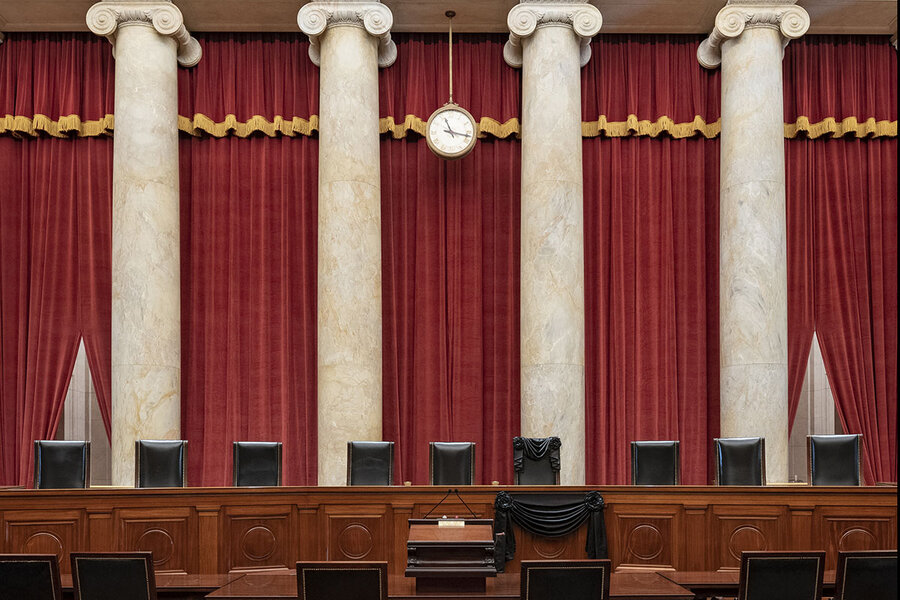Why Supreme Court battle could tarnish global luster of US judiciary
Loading...
| London
The political fight that has broken out in Washington over when and how to replace Ruth Bader Ginsburg on the Supreme Court is about more than the name of her successor. Fundamentally it is about how far politics should encroach on the judiciary.
That is an issue that has surfaced in a number of other countries recently, from the Philippines to Turkey, where authoritarian strongmen have reined in troublesome judges. The U.S. is a far more robust democracy, but the Supreme Court has never been completely immune from politics.
Why We Wrote This
The U.S. Supreme Court has never been immune to politics. But the partisan fight over Ruth Bader Ginsburg’s successor means the court could emerge dramatically changed no matter which side wins.
Franklin Roosevelt tried to expand the court, to “pack” it, but his own Democratic Party stymied the move in Congress. Such an outcome would be most unlikely today; the Senate confirmation process has grown increasingly partisan, especially so since the administration of Barack Obama.
If President Donald Trump gets his nominee onto the Supreme Court, Joe Biden – should he win the election – might be tempted to retaliate by following in FDR’s footsteps. But he has always preferred compromise, and might try to reform the institution, with term limits and a set retirement age, to free the highest court in the land from partisan political dogfights.
Ruth Bader Ginsburg will be remembered for many things: as an extraordinary legal mind and jurist, a battler for equal rights, and an unlikely icon of popular culture dubbed RBG in her later years. And now for a fiercely partisan battle over how, when, and by whom she will be succeeded on the bench.
Yet seen through a wider lens – the history of America’s highest court and a host of cautionary examples worldwide in the past few years – the unfolding succession fight is about something more than just who follows Justice Ginsburg, who died last week.
Ultimately, it’s about the rule of law: the idea that a legal system, mediated by judges independent of political pressures or favoritism, applies equally to all.
Why We Wrote This
The U.S. Supreme Court has never been immune to politics. But the partisan fight over Ruth Bader Ginsburg’s successor means the court could emerge dramatically changed no matter which side wins.
That standard has never been perfectly implemented. But at a time when politicians in America and elsewhere are trying ever harder to influence the judicial process, it is about a critical, real-world question: how far such encroachment can or should go.
In the United States, it’s also about the place of the Supreme Court, whose justices must be approved by the Senate, in a democracy built on the balance of separate and competing power centers: the judiciary, Congress, and the presidency.
With leading Republicans insisting President Donald Trump be able to fill the court seat either before or immediately after the elections in six weeks’ time, and Democrats threatening to retaliate by adding new justices under a potential President Joe Biden, a dramatically changed court may emerge no matter which side prevails.
And that would have international repercussions.
In my long experience as a foreign correspondent I was often struck by how the U.S. judiciary, and America’s system of checks and balances, are viewed as a gold standard of constitutional democracy.
I still vividly recall the reaction of friends in Europe and Asia to one particular court ruling, in the 1974 case of the United States v. Nixon. The justices ruled unanimously that the president had to hand over tape recordings during Watergate. The first response: astonishment. The second, a heartbeat later: admiration.
Strongmen vs. the judiciary
There has been no shortage recently of international examples of the way in which political sway over the judiciary can prove a key tool in authoritarian rule. Strongman regimes from Egypt and the Philippines to Venezuela have manipulated, evaded, or quashed independent legal processes.
In Turkey, President Recep Tayyip Erdoğan has reassigned or fired thousands of judges. And to the consternation of the European Union, two member states, the “illiberal democracies” of Hungary and Poland, have also moved to bring the courts under political control.
The U.S. remains a far more robust democracy. In the debate around the future of the Supreme Court, neither side is seeking all-out political control over the justice system. Besides, the high court’s history suggests that justices, no matter who appoints them, are conscious of the need to safeguard the body’s stature and independence.
But the court has never been completely immune to politics. Even the idea of expanding its size for political reasons has a precedent: Franklin Roosevelt, frustrated by opposition to his New Deal in the 1930s, embarked on an attempt to expand – “pack” – the Supreme Court.
There’s a key difference between then and now: FDR’s own Democratic Party blocked that move in Congress.
In the decades since, growing polarization in the U.S. has affected the way in which the court is viewed. For many Republican supporters, especially on the right of the party, the court has ventured too actively into political battles over issues such as gay rights, or women’s right to abortion.
Those on the other side of the argument, though, resent efforts by conservative groups and the Trump administration to “rebalance” the court and reverse those legal changes. That resentment is further fueled by polling that suggests a wide majority of Americans would oppose such a reversal.
This is not the first time that former Vice President Biden finds himself embroiled in a debate over the Supreme Court’s relationship with politics and society. It was he, as chair of the Senate Judiciary Committee in 1987, who oversaw what was then a rare rejection of a presidential nominee to the high court, Ronald Reagan’s choice of the conservative Robert Bork.
Mr. Biden rooted his argument at the time not in politics, but broad principle: whether the Constitution should be seen as a static document, or a living blueprint that adapted to evolving American social circumstances and values.
Increased partisanship
Still, by the time RBG was confirmed in 1993, her margin of Senate endorsement – 96 to 3 – remained more typical. As late as 2005, George W. Bush’s nomination of the current chief justice, John Roberts, was confirmed by 78 votes to 22.
The increasingly partisan nature of the confirmation process became clear during President Barack Obama’s administration. More than 30 Republican senators voted against his two nominees, Sonia Sotomayor and Elena Kagan. When a further vacancy arose around 10 months before the last election, the Republican-controlled Senate refused even to hold hearings on Mr. Obama’s nominee.
If Mr. Trump succeeds in placing a conservative in Justice Ginsburg’s seat, cementing the partisanship around America’s highest court, Mr. Biden would be under huge pressure to expand the court if he won the November election.
That would allow him both to balance Mr. Trump’s replacement for Justice Ginsburg and make up for the Republicans’ refusal to allow Mr. Obama his final nominee.
But Mr. Biden’s political life has been rooted in trying to achieve bipartisan compromise. He could well be minded to try to get all sides to agree on a reform of the way justices are installed.
Currently they are named for life. The imposition of term limits and a set retirement age are among the changes suggested by U.S. legal commentators as a way to free the highest court in the land from politically partisan dogfights.









